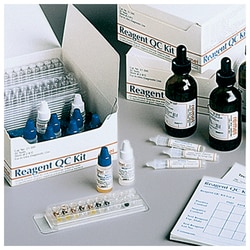Learn More
Thermo Scientific™ Reagent QC Kit
Description
Perform quality control testing of reagents that are used to identify gram-negative and gram-positive bacteria using Thermo Scientific™ Remel™ Reagent QC Kit. The Reagent QC Kit provides positive and negative controls for evaluating specific reagents used in microbiological testing. Reactions based on biochemical principles, resemble the conventional reactions that are found with microorganisms1.

Specifications
Specifications
| Certifications/Compliance | CE Marked. |
| Description | Reagent QC Kit |
| Format | QC Kit |
| Product Type | Quality Control Kit |
| Packaging Type | 30 Test/Kit |
| Quantity | 30 Tests/Kit |
The ATCC Licensed Derivative Emblem, the ATCC Licensed Derivative word mark, and the ATCC catalog marks are trademarks of ATCC™ and are used under license.
Your input is important to us. Please complete this form to provide feedback related to the content on this product.
